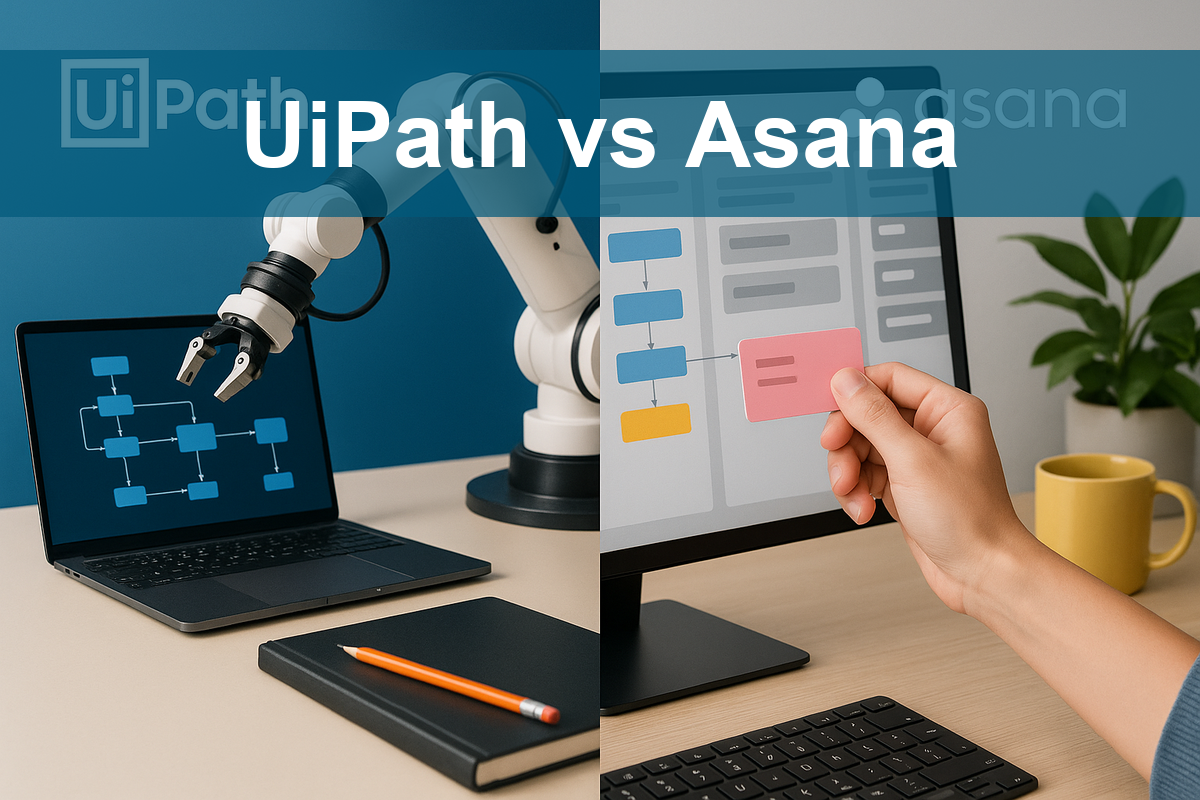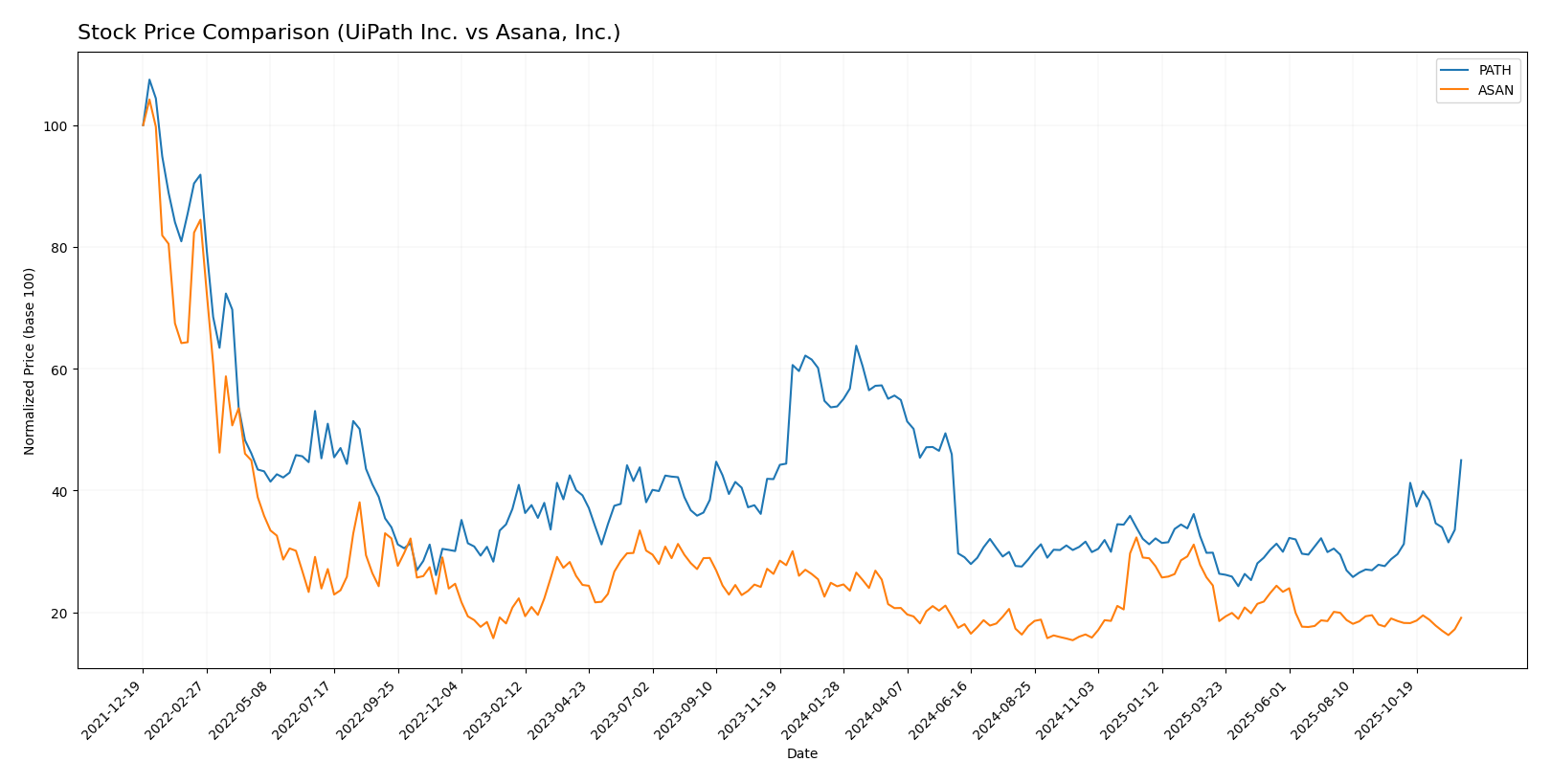As the technology landscape continues to evolve, the competition between companies specializing in software solutions is fiercer than ever. In this analysis, I will compare UiPath Inc. (PATH) and Asana, Inc. (ASAN), two prominent players in the software sector. While UiPath focuses on robotic process automation, Asana excels in work management solutions, creating an interesting juxtaposition. Both companies serve diverse industries and have innovative strategies that make them noteworthy for investors. Join me as we explore which company could be the better addition to your investment portfolio.

Table of contents
Company Overview
UiPath Inc. Overview
UiPath Inc. positions itself as a leader in robotic process automation (RPA), providing a comprehensive platform that empowers organizations to automate mundane tasks efficiently. Founded in 2005 and headquartered in New York, the company serves a diverse clientele, including sectors like banking, healthcare, and government. With a focus on simplifying automation through user-friendly tools, UiPath enables businesses to optimize workflows by integrating artificial intelligence, low-code development environments, and advanced analytics. This strategic approach allows clients to enhance productivity while ensuring compliance with regulatory standards. As of now, UiPath’s market capitalization stands at approximately $9.88B, reflecting its robust growth trajectory.
Asana, Inc. Overview
Asana, Inc., established in 2008 and based in San Francisco, is a prominent player in the work management software sector. The company’s platform facilitates seamless collaboration among teams, allowing for the effective management of tasks, projects, and organizational goals. Asana serves a broad array of industries, including technology, education, and healthcare, catering to users ranging from individual contributors to executives. With a market cap of about $3.39B, Asana focuses on enhancing team productivity and alignment through its intuitive interface and integration capabilities. The company’s commitment to continuous improvement positions it well in the competitive landscape of work management solutions.
Key similarities and differences
Both UiPath and Asana operate in the technology sector, yet their business models differ significantly. UiPath specializes in automation solutions aimed at streamlining operational processes, while Asana provides a platform for project management and team collaboration. Despite their distinct focuses, both companies emphasize enhancing productivity and efficiency for their users, catering to various industries.
Income Statement Comparison
The following table summarizes the latest income statement metrics for UiPath Inc. and Asana, Inc., providing a clear view of their financial health and performance.
| Metric | UiPath Inc. (PATH) | Asana, Inc. (ASAN) |
|---|---|---|
| Market Cap | 9.88B | 3.39B |
| Revenue | 1.43B | 723.88M |
| EBITDA | -145.34M | -229.55M |
| EBIT | -162.57M | -247.09M |
| Net Income | -73.69M | -255.54M |
| EPS | -0.13 | -1.11 |
| Fiscal Year | 2025 | 2025 |
Interpretation of Income Statement
In 2025, UiPath reported revenue growth to 1.43B, reflecting a significant increase from 1.31B in 2024. Conversely, Asana also showed improvement, with revenue rising from 652.50M in 2024 to 723.88M. However, both companies remain unprofitable, with UiPath’s net loss reducing from 89.88M to 73.69M, while Asana’s losses widened from 257.03M to 255.54M. Notably, both companies are experiencing operational challenges, indicated by negative EBITDA and EBIT, suggesting that while revenues are increasing, cost management remains a critical area for improvement.
Financial Ratios Comparison
Here’s a comparative overview of the most recent revenue and financial ratios for UiPath Inc. (PATH) and Asana, Inc. (ASAN).
| Metric | UiPath Inc. (PATH) | Asana, Inc. (ASAN) |
|---|---|---|
| ROE | -4.0% | -112.3% |
| ROIC | -7.4% | -54.0% |
| P/E | -108.0 | -19.2 |
| P/B | 4.31 | 21.52 |
| Current Ratio | 2.93 | 1.44 |
| Quick Ratio | 2.93 | 1.44 |
| D/E | 0.04 | 1.18 |
| Debt-to-Assets | 2.72% | 30.1% |
| Interest Coverage | N/A | N/A |
| Asset Turnover | 0.50 | 0.81 |
| Fixed Asset Turnover | 14.41 | 2.76 |
| Payout Ratio | 0% | 0% |
| Dividend Yield | 0% | 0% |
Interpretation of Financial Ratios
Both companies demonstrate significant challenges, as indicated by their negative ROE and ROIC values, reflecting ongoing operational struggles. While UiPath shows a more favorable liquidity position with a higher current and quick ratio compared to Asana, it also has a higher P/B ratio, suggesting a premium valuation. Asana’s substantial debt-to-equity ratio raises concerns about its financial leverage. Overall, caution is warranted in investing in either company given these metrics.
Dividend and Shareholder Returns
Neither UiPath Inc. (PATH) nor Asana, Inc. (ASAN) pays dividends, reflecting a strategic focus on reinvestment for growth. Both companies are in high-growth phases, prioritizing R&D and expansion over immediate returns to shareholders. However, they engage in share buyback programs, which can signal confidence in their future prospects. This lack of dividend payments and reliance on share repurchases suggest a commitment to long-term value creation, albeit with the inherent risks associated with growth-oriented strategies.
Strategic Positioning
UiPath Inc. (PATH) holds a significant market share in the robotic process automation (RPA) sector, leveraging its advanced AI-driven platform to maintain a competitive edge. Asana, Inc. (ASAN), while strong in the work management software space, faces increasing pressure from broader competitors in the software application market. Both companies must navigate ongoing technological disruptions and evolving customer needs, necessitating continuous innovation and strategic adaptation to retain and grow their respective market positions.
Stock Comparison
This section provides a detailed overview of the weekly stock price movements for UiPath Inc. (PATH) and Asana, Inc. (ASAN), highlighting key price dynamics and trends over the past year.

Trend Analysis
UiPath Inc. (PATH) Over the past year, PATH has experienced a price change of -16.17%, indicating a bearish trend. The stock has seen notable price fluctuations, with a high of 26.35 and a low of 10.04. The trend is characterized by acceleration, with a standard deviation of 4.02 suggesting significant volatility. In the recent period from September 21, 2025, to December 7, 2025, PATH has shown a positive price change of 56.57%, with a lower standard deviation of 1.98, indicating a more stable upward movement.
Asana, Inc. (ASAN) ASAN has faced a more pronounced downturn, with a price change of -23.12% over the past year, also reflecting a bearish trend. The stock has fluctuated between a high of 24.15 and a low of 11.53. The trend is currently decelerating, supported by a standard deviation of 2.93. In the recent timeframe from September 21, 2025, to December 7, 2025, ASAN’s price change was a minimal 0.6%, with a slight downward slope of -0.09, indicating a neutral trend with reduced volatility (standard deviation of 0.69).
In summary, PATH may present a more favorable short-term outlook compared to ASAN, which is currently underperforming.
Analyst Opinions
Recent analyst recommendations for UiPath Inc. (PATH) indicate a strong consensus to buy, with an overall rating of A- based on solid scores in return on equity and assets. Analysts highlight its robust growth potential and manageable debt levels. In contrast, Asana, Inc. (ASAN) has received a consensus sell rating, with a D+ score reflecting significant concerns over its financial metrics. Analysts emphasize its poor performance in return on equity and cash flow, advising caution for potential investors. Overall, the consensus for PATH is buy, while ASAN is sell.
Stock Grades
As we assess the latest stock ratings for UiPath Inc. and Asana, Inc., we find a mix of maintained grades reflecting the analysts’ cautious outlook.
UiPath Inc. Grades
| Grading Company | Action | New Grade | Date |
|---|---|---|---|
| Canaccord Genuity | maintain | Buy | 2025-12-04 |
| Mizuho | maintain | Neutral | 2025-12-04 |
| Barclays | maintain | Equal Weight | 2025-12-04 |
| BMO Capital | maintain | Market Perform | 2025-12-04 |
| Needham | maintain | Hold | 2025-12-04 |
| Wells Fargo | maintain | Equal Weight | 2025-12-04 |
| Evercore ISI Group | maintain | In Line | 2025-12-04 |
| RBC Capital | maintain | Sector Perform | 2025-12-04 |
| UBS | upgrade | Neutral | 2025-10-23 |
| BMO Capital | maintain | Market Perform | 2025-10-02 |
Asana, Inc. Grades
| Grading Company | Action | New Grade | Date |
|---|---|---|---|
| DA Davidson | maintain | Neutral | 2025-12-04 |
| Citigroup | maintain | Neutral | 2025-12-03 |
| UBS | maintain | Neutral | 2025-12-03 |
| RBC Capital | maintain | Underperform | 2025-12-03 |
| Morgan Stanley | maintain | Underweight | 2025-09-04 |
| Piper Sandler | maintain | Overweight | 2025-09-04 |
| Baird | maintain | Neutral | 2025-09-04 |
| JMP Securities | maintain | Market Outperform | 2025-06-04 |
| Scotiabank | maintain | Sector Perform | 2025-06-04 |
| Morgan Stanley | maintain | Underweight | 2025-06-04 |
In summary, UiPath maintains a generally positive outlook with several “Buy” and “Hold” ratings, while Asana shows more mixed sentiments, with a notable “Underperform” grade from RBC Capital. Investors should consider this nuanced landscape as they make their investment decisions.
Target Prices
The consensus target prices for UiPath Inc. (PATH) and Asana, Inc. (ASAN) reflect a cautious optimism among analysts.
| Company | Target High | Target Low | Consensus |
|---|---|---|---|
| UiPath Inc. | 17 | 14 | 16 |
| Asana, Inc. | 16 | 14 | 15 |
For UiPath, the target consensus price of 16 is below its current price of 18.57, suggesting potential overvaluation. In contrast, Asana’s consensus price of 15 is slightly above its current price of 14.285, indicating a more favorable outlook.
Strengths and Weaknesses
Below is a comparative analysis of the strengths and weaknesses of UiPath Inc. (PATH) and Asana, Inc. (ASAN).
| Criterion | UiPath Inc. (PATH) | Asana, Inc. (ASAN) |
|---|---|---|
| Diversification | Moderate | Low |
| Profitability | Negative margins | Negative margins |
| Innovation | High | Moderate |
| Global presence | Strong | Moderate |
| Market Share | Growing | Moderate |
| Debt level | Low | High |
Key takeaways indicate that while UiPath shows strength in innovation and a strong global presence, Asana suffers from higher debt levels and lower diversification. Both companies exhibit negative profitability, which warrants caution for potential investors.
Risk Analysis
The following table outlines key risks associated with two companies, UiPath Inc. (PATH) and Asana, Inc. (ASAN).
| Metric | UiPath Inc. | Asana, Inc. |
|---|---|---|
| Market Risk | Moderate | High |
| Regulatory Risk | Low | Moderate |
| Operational Risk | High | High |
| Environmental Risk | Low | Moderate |
| Geopolitical Risk | Low | High |
Both companies face significant operational and market risks. Asana has a higher exposure to market fluctuations and operational inefficiencies, which can heavily impact its financial stability, given its recent net income losses.
Which one to choose?
When comparing UiPath Inc. (PATH) and Asana, Inc. (ASAN), the fundamentals present a contrasting picture. UiPath has a higher gross profit margin of 82.73% compared to Asana’s 89.34%. However, PATH has a significantly better overall rating of A- versus ASAN’s D+, indicating stronger operational performance and financial health. While PATH shows a recent price trend improvement of 56.57%, ASAN’s price has seen a minor increase of only 0.6%. Analysts are more optimistic about PATH, reflected in its lower debt-to-equity ratio (0.04) compared to ASAN (1.18), suggesting better risk management.
For growth-oriented investors, I recommend PATH for its potential upside and operational efficiency, while conservative investors may opt for ASAN due to its slightly better margins, despite its overall lower performance.
Both companies face risks, including market dependence and competitive pressures, which could impact their future performance.
Disclaimer: This article is not financial advice. Each investor is responsible for their own investment decisions.
Go further
I encourage you to read the complete analyses of UiPath Inc. and Asana, Inc. to enhance your investment decisions:



